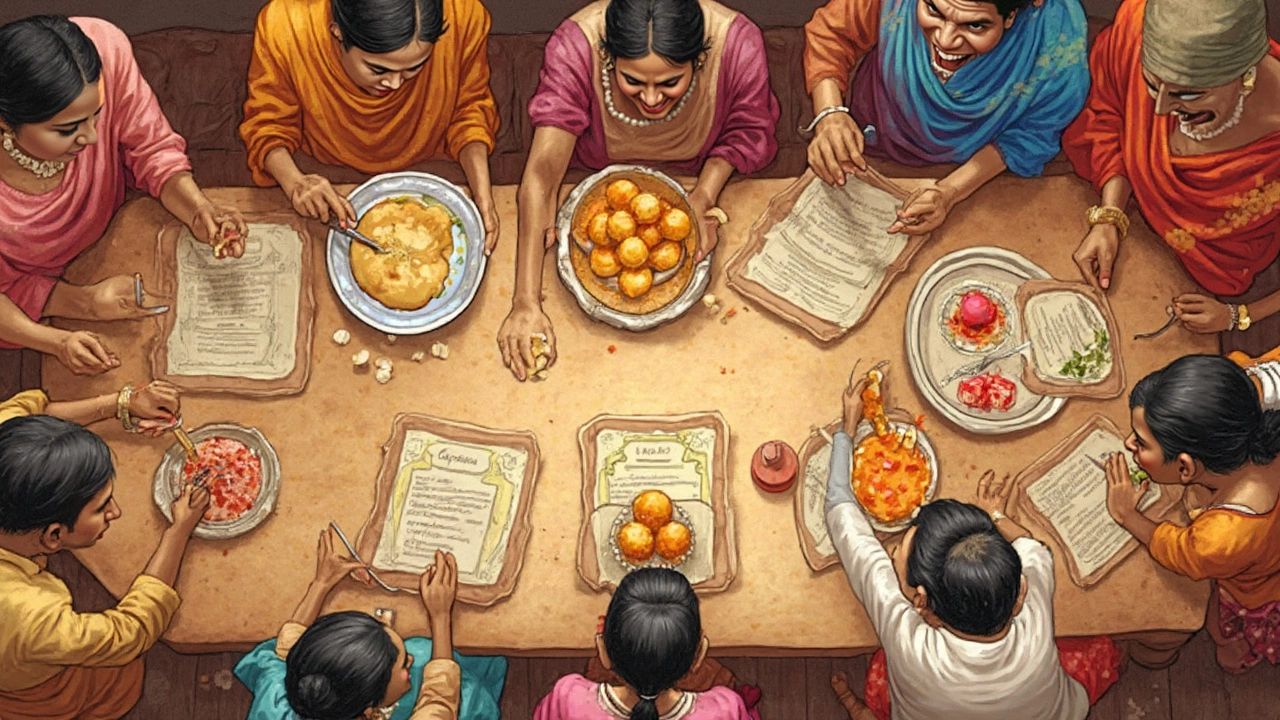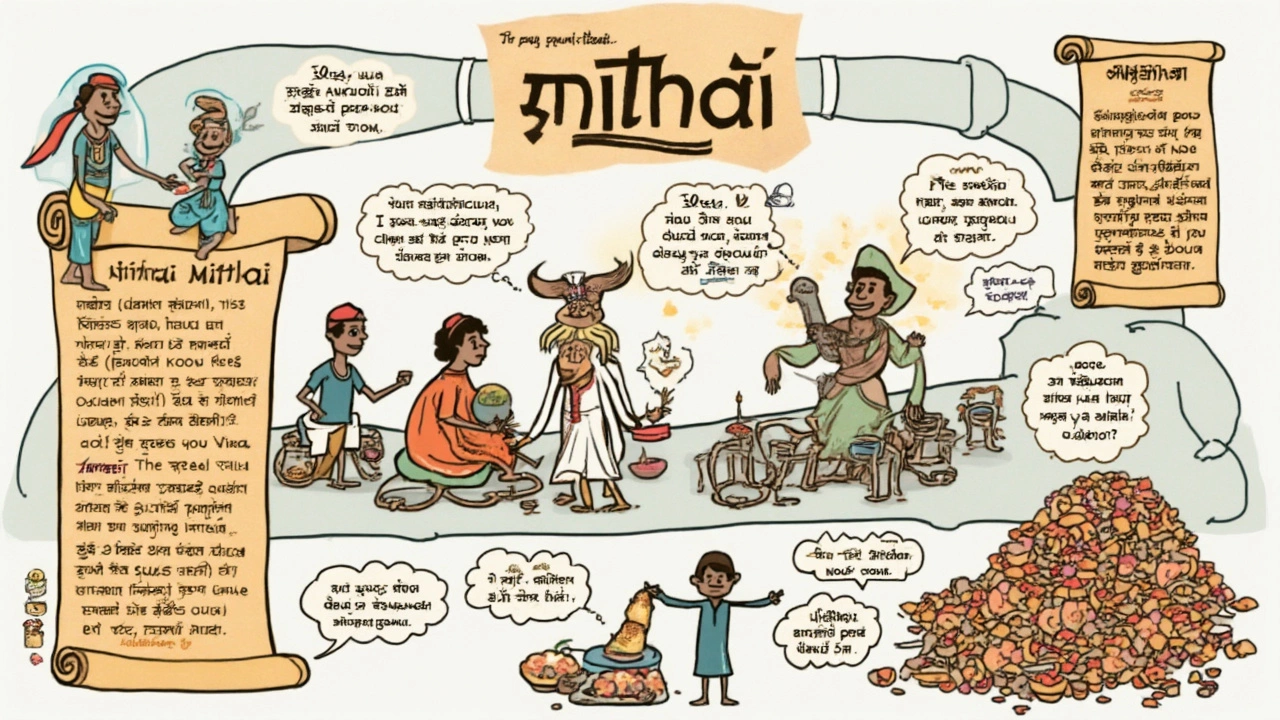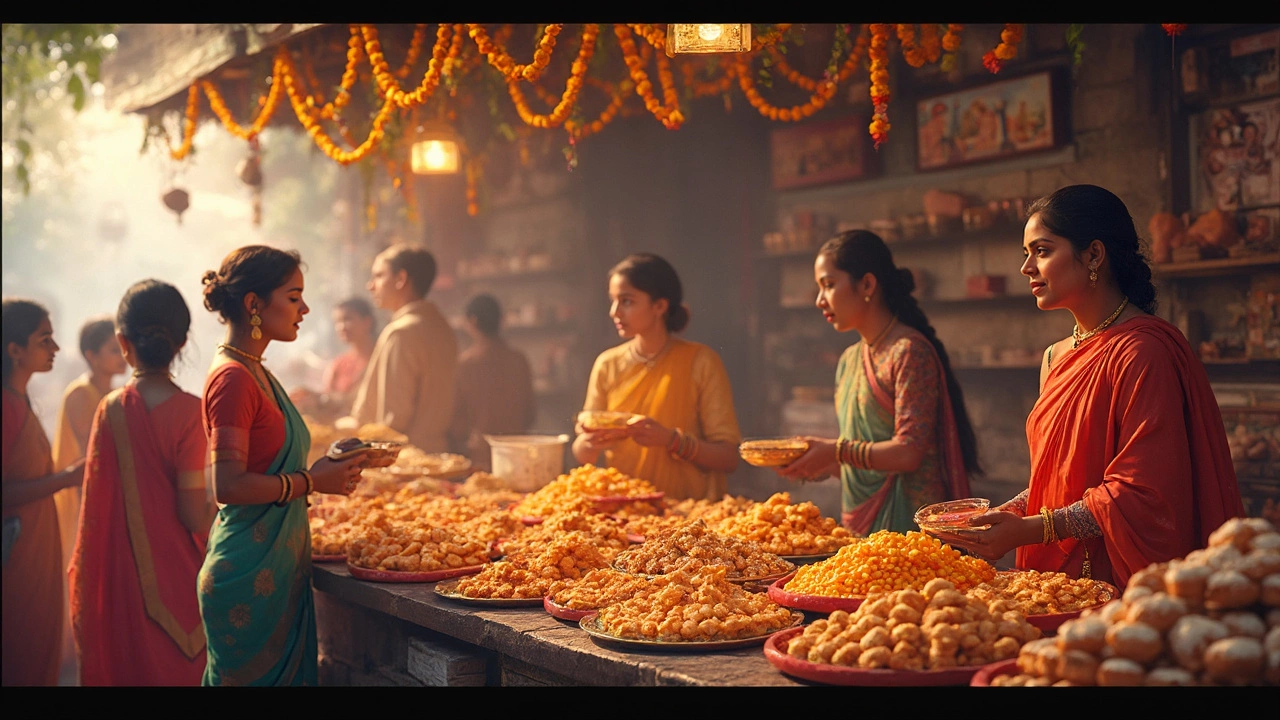Walk into any Indian market and you'll spot piles of colorful, syrupy treats. If you ask a local the word for 'sweet,' you’ll probably hear 'mithai.' This word pops up on shop signs, party menus, recipes, and even in family WhatsApp groups during Diwali. 'Mithai' (मिठाई) is what most Hindi speakers use when talking about all kinds of Indian desserts, from creamy barfis to deep-fried jalebis.
It's not just a generic label. If you've got a recipe that says “mithai,” it’s a clear sign you’re in for something sugary, milky, and possibly sprinkled with nuts and silver leaf. Next time you’re at a sweet shop, asking for 'mithai' gets you a whole platter of options. Knowing this word can be a lifesaver if you’re browsing recipes or trying to decode the dazzling menus at Indian weddings.
- The Indian Word for Sweet Explained
- Where the Word 'Mithai' Comes From
- Different Words for Sweet Across India
- Ordering Sweets in India: Quick Tips
- How Indian Sweets Get Their Names
The Indian Word for Sweet Explained
The main Indian word for sweet is mithai. If you ask someone in North India for a sweet, they'll almost always point you toward mithai. This word isn’t just for Western-style candy or chocolate; it covers a whole universe of Indian desserts made with ingredients like milk, ghee, sugar, and nuts. Mithai is most commonly used in Hindi-speaking regions, but you’ll hear it in pop culture, offices, and while scrolling through Indian food blogs.
Indian sweets are a huge part of local life. Every festival, wedding, or family gathering involves a box (or ten) of mithai. When someone moves into a new house, has a baby, or gets a promotion, it’s custom to hand out mithai to neighbors or coworkers. It’s a form of sharing happiness. Even outside India, the word mithai usually means classic Indian-style desserts, not generic sweets or baked goods.
People sometimes get confused because shop names use different spellings—mithai, mithayi, or even mitthai—but they all point to the same thing: traditional Indian sweets. When browsing a sweet shop menu, you’ll notice varieties like gulab jamun, rasgulla, peda, laddu, and kaju katli, but if you just ask for mithai, you’re asking for a sweet treat from this whole group.
Here’s a useful table with popular Indian sweets labeled as mithai, plus what they’re made from:
| Sweets (Mithai) | Main Ingredients |
|---|---|
| Gulab Jamun | Milk solids, sugar syrup |
| Laddu | Gram flour, sugar, ghee |
| Barfi | Condensed milk, nuts, sugar |
| Rasgulla | Cottage cheese, sugar syrup |
| Kaju Katli | Cashew, sugar |
So, next time you’re following an Indian sweet recipe or ordering treats at a shop, knowing the term mithai helps you get exactly what you want—an authentic, intensely sweet bite from India’s best desserts.
Where the Word 'Mithai' Comes From
Ever wondered why the word 'mithai' pops up everywhere when talking about Indian sweets? Here’s the scoop. ‘Mithai’ comes from the Sanskrit word ‘madhur’ and the Hindi word 'meetha,' both of which mean ‘sweet.’ Over time, 'mithai' became the everyday word for sweet snacks or desserts in India, much like how ‘candy’ fits into English conversations. No one uses it just for one type—it's a whole universe of desserts in just one word.
The term 'mithai' rolled into kitchens and bazaars across northern India first. As India’s trade routes spread ideas, food, and even sugar, ‘mithai’ went mainstream. Persian and Arabic traders brought their own sweet recipes, and they merged with local traditions. That mash-up is how classics like gulab jamun and jalebi were born—today, you might see ‘mithai’ used in Urdu, Bengali, and even some parts of southern India, though there are other names in local languages.
Ever heard anyone call pastries ‘mithai’ outside of India? Not really. It’s a uniquely Indian word, and anyone working in an Indian bakery or sweet shop knows exactly what it means. You’ll probably spot it on popular Indian sweet box packaging in grocery stores around the world, too.
Here’s a quick look at how ‘mithai’ shows up in different Indian language families:
| Language | Word for 'Sweet' | Spoken Region |
|---|---|---|
| Hindi/Urdu | Mithai | North, Central India, Pakistan |
| Bengali | Mishti | West Bengal, Bangladesh |
| Tamil | Inippu | Tamil Nadu |
| Gujarati | Mithai | Gujarat |
| Punjabi | Mithai | Punjab |
One tip—if you’re looking through an Indian recipe book or talking to friends at a festival, listening for ‘mithai’ is the best way to catch all the sweet action. It’s your password to Indian dessert heaven.

Different Words for Sweet Across India
India isn’t just one big place with one language. Each region has its own word for sweet, so ‘mithai’ doesn’t cover everything. If you hop from Delhi to Chennai or from Kolkata to Mumbai, you’ll hear different words in different languages. Knowing a few of these can help you spot the dessert section no matter where you are.
- Mithai (मिठाई) – Most common in Hindi-speaking areas like North India
- Mishti (মিষ্টি) – This is what Bengali folks in West Bengal and Bangladesh say. 'Mishti Doi' (sweet yogurt) is way more fun to order when you know the word.
- Sweets – English speakers in Indian cities sometimes just use ‘sweets,’ especially at bakeries or supermarkets.
- Meetha (मीठा) – In some parts of North India and Pakistan, this word literally means ‘sweet’ and can refer to anything sugary.
- Halwa/Halwaa – In South India, you’ll hear people asking for ‘halwa’ at sweet shops, meaning both the dish and ‘something sweet’ in general.
- Thene (తేనె) – In Telugu, the word for honey is often used to refer to something super sweet or desserts.
Here’s a quick table breaking down regional words you might spot on your next food adventure:
| Region/Language | Word for Sweet | Example Dish |
|---|---|---|
| Hindi/North India | Mithai | Barfi, Jalebi |
| Bengali/West Bengal | Mishti | Mishti Doi, Sandesh |
| Tamil/South India | Inippu | Mysore Pak |
| Telugu/Andhra Pradesh | Thene/Teepi | Pootharekulu |
| Gujarati/Gujarat | Mithai / Mithu | Mohanthal, Penda |
| Punjabi/Punjab | Mithai / Meetha | Pinni |
Don’t be surprised to hear a mix of these words in a single city, since people move all over India. If you’re following Indian sweets recipes, sometimes the region’s word pops up right in the title. That’s a handy clue for spotting something you might want to try (or Google for a recipe later).
Ordering Sweets in India: Quick Tips
First time at an Indian sweet shop? It might look chaotic, but it’s actually pretty simple once you know a few tricks. Almost every sweet shop displays their best sellers right up front—the brightest, stickiest, and most tempting stuff. Look for glass cases packed with mithai, and you’ll usually find name cards in both Hindi and English.
Don’t hesitate to ask for a small sample. Most shopkeepers expect that, and trying before you buy is totally normal, especially if you’re unsure about a new treat. If you want a mix, just say the magic word: “assorted mithai.” They’ll pick a variety for you, usually based on what’s popular.
- If you’re lost in the options, look for these crowd-pleasers: gulab jamun (brown syrupy balls), jalebi (orange spirals), and kaju katli (diamond-shaped cashew fudge).
- Most mithai are sold by weight. Common portions are 250g, 500g, or 1kg. Say the quantity, and the shopkeeper grabs a box and fills it up for you.
- Watch out for nuts. Many Indian sweets contain cashews, pistachios, or almonds. If you have allergies, ask, “Is there any kaju or badam?” (kaju = cashew, badam = almond).
- Planning to bring sweets as a gift? Shops can wrap boxes with gift paper and colorful string—the shopkeeper usually offers this if you mention it’s for gifting.
Unlike desserts in some countries, Indian mithai isn’t just for after meals. People buy them as snacks, religious offerings, even as thank-you tokens. If you just ask for the Indian sweets everyone’s ordering, you’ll always walk out with a crowd favorite. And here’s a pro tip: fresh mithai tastes best the same day, so buy only as much as you’re planning to eat or share soon.

How Indian Sweets Get Their Names
Ever wonder why rasgulla is called rasgulla or why ladoo always means a round treat? There’s actually a method behind these names, and once you know it, picking out a new Indian sweet from a menu feels a lot easier.
Many names come straight from the main ingredient or the shape. For example, 'laddu' or 'ladoo' just means ‘ball’—so pretty much any round sweet is a type of ladoo. 'Barfi' means ‘snow’ in Persian, a nod to its usually white, fudge-like appearance, though you’ll see it in every color from mango yellow to pistachio green. 'Jalebi' is named after the Persian word for a coiled shape, matching its pretzel-like look and syrupy texture.
Some names give a literal heads-up about what’s inside. Take 'besan ladoo': ‘besan’ is chickpea flour. 'Kaju katli' means it’s made with cashews (kaju) and cut in slices or diamonds (katli). If you see ‘peda’ on a menu, think small, flattened discs that are usually made with condensed milk and cardamom.
Regional languages often add their own twist. What’s called 'sandesh' in Bengal (made mainly of paneer or chhena and sugar) becomes 'mithai' in North India as a generic term, and ‘mysore pak’ in the South takes its name from the city of Mysore.
Pro tip: Look for clues right in the name. Anything ending in 'halwa' usually means a soft, melt-in-the-mouth dessert. Words like ‘shahi’ suggest it’s rich and meant for royalty—so those usually have more ghee and nuts. The next time you scan a sweets counter, see if you can spot the pattern!
